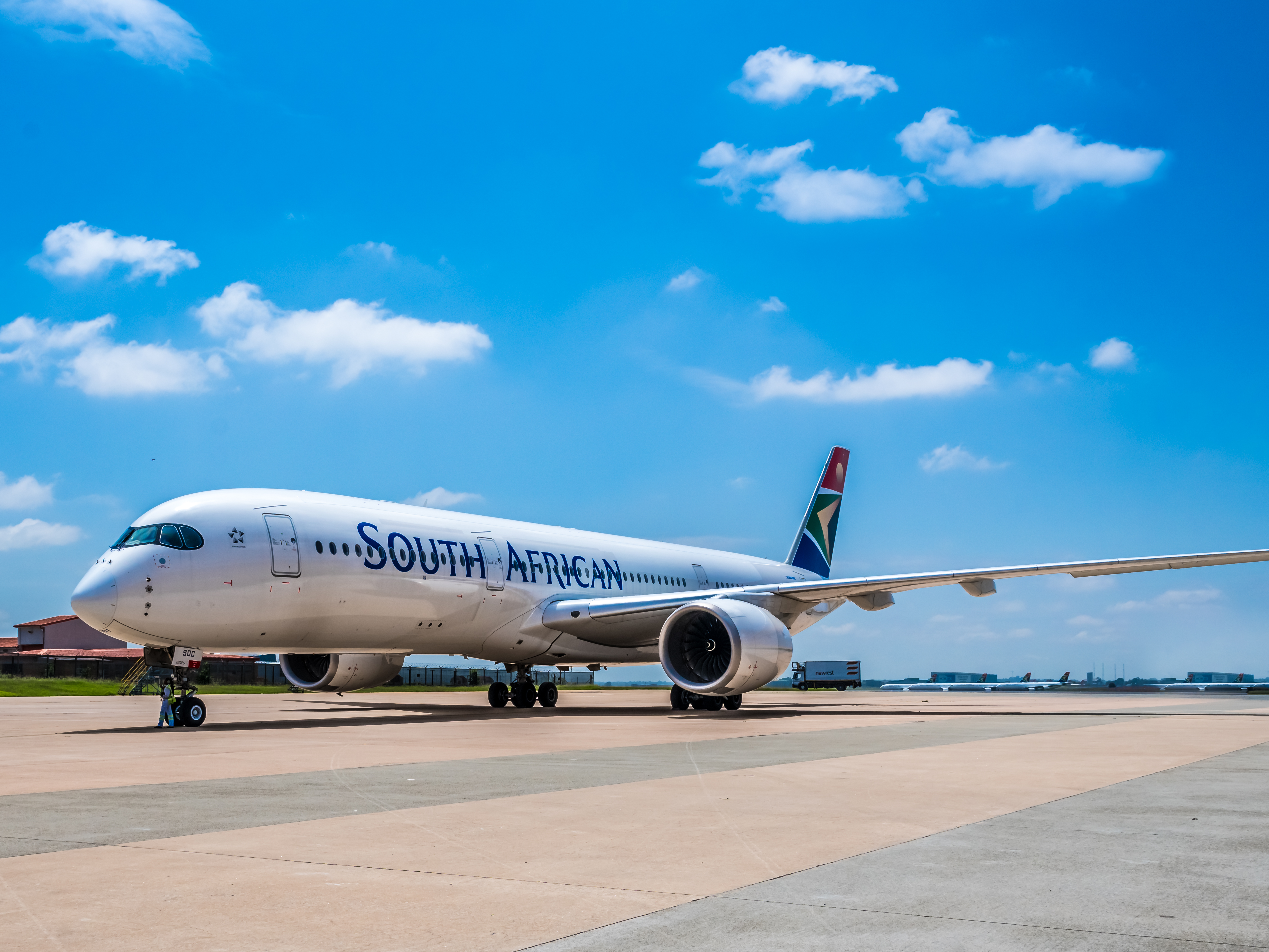- South African Airways will no longer receive government funding, putting its future in jeopardy.
- Rescuers tasked with providing options for the airline moving forward have said that a shutdown is inevitable, FlightGlobal reported.
- The South African government has also stated its intention to form a new airline, according to Reuters.
- Visit Business Insider’s homepage for more stories.
South African Airways is on the brink of disappearance after years of financial struggles.
The long-suffering carrier has been denied further state funding and, as FlightGlobal reported, business rescuers entrusted with the difficult task of rescuing the 86-year-old airline have given it two options: liquidation or a wind-down and sale process. Either way, South African Airways will, without intervention, no longer remain in operation.
It was always going to be a tumultuous road for the state-owned enterprise mired in crippling debts, the COVID-19 pandemic undoubtedly sped up the airline’s impending collapse. The most recent setback for the airline came as South Africa greatly restricted international travel after enacting drastic measures in order to stay afloat in the last year including slashing nearly all domestic routes within the country.
While tthe arrival of the Airbus A350-900 XWB, which debuted on the Johannesburg-New York route in January, looked like it may have marked the beginning of a new era for the carrier, South Africa may lose its airline less than six months from the plane’s debut.
Take a look at how South African arrived at what is likely the end of its journey.
The airline itself dates back to 1934 when South Africa's Union Airways was nationalized to form the new South African Airways. The state-owned airline would become the flag carrier of South Africa, which was still part of the British Empire at the time.

Source: South African Airways
Initial operations for South African included regional flights within Africa. Intra-African and domestic flights were operated by aircraft including the Junkers Ju 52, Douglas DC-3, and Junkers Ju 86.

Source: South African Airways
Once World War II ended, South African expanded beyond the shores of its home continent with a multi-stop flight to the heart of the British Empire. The route was known as the "Springbok" service, after the national animal of South Africa.

Source: South African Airways
The 34-hour, three-day service initially flown by an Avro York aircraft, stopped in Nairobi, Kenya; Khartoum, Sudan; Cairo, Egypt; and Castel Benito, Libya, before arriving in Bournemouth, England.

Source: South African Airways
Springbok would also become the radio callsign for South African Airways flights.

More modern aircraft from Western manufacturers including the Lockheed Constellation L-749 and Douglas DC-4 were later added, helping fuel international expansion.

Source: South African Airways
The airline added flight attendants on its services in 1946 and later added in-flight movies to some of its flights in the same decade.

Source: South African Airways
South Africa entered the jet age in 1953 with a British Overseas Airways Corporation de Havilland Comet operated by South African Airways that flew from Johannesburg to London.

Source: South African Airways
Intercontinental expansion continued with South African Airways later growing its route network to Australia in 1957 with "Wallaby" service.

Source: South African Airways
The 1960s then saw further expansion to South America, with flights to Rio de Janeiro, and then North America, with flights to New York, using the Boeing 707.

Source: South African Airways
South African hit a milestone in the 1970s with its first Boeing 747 aircraft, an aircraft that had begun flying passengers only at the beginning of the decade. The quad engine aircraft quickly became a status symbol for the world's airlines.

Source: South African Airways
Other new arrivals included the Boeing 737…

Source: South African Airways
And Airbus A300.

Source: South African Airways
South African was also one of the first commercial operators of a unique Boeing product, the 747SP.

Source: South African Airways
A shortened version of the popular Jumbo Jet but with the same four engines, the 747SP offering extended ranges unmatched by most aircraft of the time. The range of the 747SP was so great that South African flew it from Seattle to Cape Town nonstop, a distance of over 8,800 nautical miles, on its delivery flight.

Source: South African Airways
While airlines liked the 747SP for its performance capabilities, South African had a different reason involving the country's apartheid policy.

Due to the discriminatory policy, some African countries had restricted South African Airways flights from entering their airspaces and the airline would often have to fly indirect routes to get to Europe.

Source: New York Times
The Boeing 747SP allowed for South African to go around the countries without having to stop for fuel on the way to Europe. Other aircraft frequently used Cape Verde as a refueling stop for flights to Europe, despite the archipelago's location off the coast of West Africa.

Source: New York Times
A route from Johannesburg to Athens on the 747SP, for example, stopped in Lisbon and Rome along the way. The flight flew direct or with one stop to Lisbon, and then headed into the continent.

Source: South African Airways
The 1980s then saw turbulence for the carrier as Western nations adopted sanctions against South Africa for its apartheid policies. Flights to the US and Australia were revoked in addition to the countries that had barred South African's flights.

Source: South African Airways
When apartheid ended in the 1990s, South African was allowed to grow its route network once again and the airline no longer needed to fly the long, costly routes to avoid some nations.

Source: South African Airways
One of the most notable displays of the new airline came in 1995 during the Rugby World Cups when a South African Airways Boeing 747 did a flyover of the stadium with "Good Luck Bokke," a nickname for the South African team, painted on the belly. The feat was repeated multiple times in later years by other airlines.

Source: South African Airways and Safair
The decade also saw the airline win the title of Africa's leading airline from 1994 on to 2015. The 1990s, however, also saw the airline begin its financial losing streak.

Source: QZ
The 2000s saw South African undergo a fleet renewal where most of its long-haul Boeing jets were retired in favor of European-built Airbus planes. The new long-haul flagships became the Airbus A330…

Source: Planespotters.net
And A340-600.

Source: Planespotters.net
South African was later brought into organizations to which it had been denied including the International Civil Aviation Organization and joined the Star Alliance.

Source: South African Airways
Its new-found praise and acceptance, however, couldn't replace the financial woes of the airline. In 2019, South African entered the equivalent of bankruptcy protection and began restructuring after racking up nearly $3 billion in debt.

Source: QZ
Despite being in the midst of restructuring, South African leased a new aircraft, the Airbus A350-900 XWB, which ultimately launched on the Johannesburg-New York route in January.

The swanky new aircraft would be ideal for the ultra-long-haul routes that South African planned to use them for.

With the new aircraft in the air and flying passengers, the hope was that South African might have a plan to save itself from collapse.

South Africa's government, which has been incrementally providing relief, however, ultimately pulled the plug in April.

Source: FlightGlobal
Without intervention from either the government or a private buyer willing to keep the airline going, South African Airways is likely to disappear from the skies for good.

There is a glimmer of hope for South African. Governments don't typically let their airlines vanish completely, the most recent example being Alitalia. The iconic Italian airline was faced with a similarly uncertain future following a failed sale. Despite vows to the contrary, the government stepped in and re-nationalized the airline.
South African Airways' disappearance would not only cost South African jobs but would make the country largely dependent on foreign carriers for international flights beyond the sub-Saharan region. Nearly 5,000 jobs are on the line as the airline teeters on the brink, according to Bloomberg.
The South African government, however, has been in talks with union leaders to create a new airline from the ashes of South African Airways, Reuters reported. Reports by Bloomberg indicate that the enterprise would ideally be both privately and publicly owned.
"The old SAA is dead, there is no doubt about that," Minister of Public Enterprises Pravin Gordhan told Bloomberg. "But what will take its place may be some or all of the old SAA and maybe some other airlines too."
A deadline to cement the final decision on South African's future is set to expire on May 8, according to the outlet.

